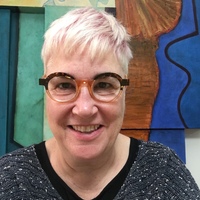- Ph.D. in Art History, University of Chicago, 1999
MFA in Painting, School of the Art Institute of Chicago, 1985edit
An examination of the role of pedagogical diagrams in the practices of several canonical American modernists. Part of a special issue on Abstraction. Available online at
https://www.open-set.com/author/bjaffee/
https://www.open-set.com/author/bjaffee/
Research Interests:
As an artist-designer, Edgar Miller dedicated his career to working across artistic media, blurring the boundaries of what are understood separately as the applied and the fine arts. In this respect, Miller’s practice dovetails neatly... more
As an artist-designer, Edgar Miller dedicated his career to working across artistic media, blurring the boundaries of what are understood separately as the applied and the fine arts. In this respect, Miller’s practice dovetails neatly with what was the dominant approach to arts pedagogy at the School of the Art Institute of Chicago [SAIC] when the young artist first arrived there as a student in 1917. The importance of interdisciplinarity at SAIC in the 1920s may be difficult for us to recognize today, not least because of Miller’s somewhat disdainful recollections of his time as a student. This project reconstructs the mainstream of American art and design education and demonstrates the importance of that milieu to Miller’s development.
Available online at https://www.edgarmiller.org/artist-designer
Available online at https://www.edgarmiller.org/artist-designer
Research Interests:
In his recent book, Art Subjects: Making Artists in the American University, Howard Singerman describes as ironic the fact that when the design curriculum developed at the German Bauhaus in the 1920s was assimilated in the United States... more
In his recent book, Art Subjects: Making Artists in the American University, Howard Singerman describes as ironic the fact that when the design curriculum developed at the German Bauhaus in the 1920s was assimilated in the United States some fifteen years later it was as ...
Research Interests:
In 1957 the art historian Meyer Schapiro suggested that the significance of avant-garde art lay in its positing of an alternative to the technological extremes of corporate capitalism, observing that, within the developmental logic of... more
In 1957 the art historian Meyer Schapiro suggested that the significance of avant-garde art lay in its positing of an alternative to the technological extremes of corporate capitalism, observing that, within the developmental logic of moder-nity, the realm of the historically fine arts of ...
Research Interests:
The surprisingly modern content of an early twentieth-century education at the School of the Art Institute of Chicago was a formative experience—or, at the very least, an influential encounter—for a number of artists who served on the... more
The surprisingly modern content of an early twentieth-century education at the School of the Art Institute of Chicago was a formative experience—or, at the very least, an influential encounter—for a number of artists who served on the faculty of the Broadmoor Art Academy and its successor, the Colorado Springs Fine Art Center in its first several decades. The role of what is described here as the “Chicago Way” of art education in shaping the pedagogy and practice of a few of these artists, including Francis Drexel Smith, Laura Gilpin, Boardman Robinson, Edgar Britton, and Emerson Woelffer, is explored. The argument also touches on questions of margins and centers that are always in play as part of any discussion of regionalism, in an attempt to determine the relevancy of the developing paradigm to an understanding of canonically modernist figures such as Georgia O’Keeffe and Jackson Pollock. Pointing as well towards connections between these artists and realists George Bellows and Thomas Hart Benton, the essay offers an implicit critique of such standard historiographic devices as the divide between abstraction and figuration in our understanding of modern American art. In conclusion, some context is offered for why the story of modernism in the Middle West has not previously served as a model for mainstream art historical narrative.
Research Interests:
Born out of the seismic cultural shifts associated with the late 1960s-early 1970s, coming of age in the hyper-inflated art world of the 1980s, and, in its maturity, embracing its role in the global re-theorization of art practices that... more
Born out of the seismic cultural shifts associated with the late 1960s-early 1970s, coming of age in the hyper-inflated art world of the 1980s, and, in its maturity, embracing its role in the global re-theorization of art practices that characterized the 1990s, the independent, Chicago-based New Art Examiner was a fearless chronicler of almost three decades of art world change.
Research Interests:
Encyclopedia entry published by Oxford Reference in the Grove Encyclopedia of American Art, ed. Joan Marter.
Research Interests:
Encyclopedia entry published by Oxford Reference in the Grove Encyclopedia of American Art, ed. Joan Marter.
